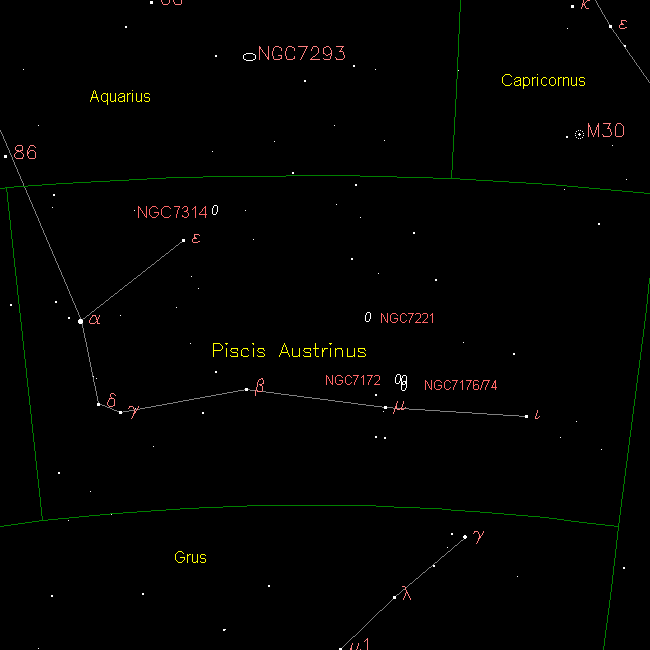[/caption]
Located just south of the ecliptic plane, Piscis Austrinus was one of the original 48 constellations charted by Ptolemy, and it remains one of the 88 modern constellations adopted by the IAU. Spanning 245 square degrees of sky, it ranks 60th in size. Piscis Austrinus contains 7 mains stars in its asterism and has 21 Bayer Flamsteed designated stars within its confines. It is bordered by the constellations of Capricornus, Microscopium, Grus, Sculptor and Aquarius. Piscis Austrinus can be seen by all observers located at latitudes between +55° and ?90° and is best seen at culmination during the month of October.
Piscis Austrinus is also known as Piscis Australis – Latin for the “Southern Fish”. Prior to the 20th century, it was also known as Piscis Notius. In mythology it is said to represent the parent of Pisces. Perhaps the legend came from the Syrians who did not eat fish, but worshipped them as gods. The Greeks also kept fish ponds at their temples and one legend tells of woman who was turned into a mermaid when she threw herself into a pond in a suicide attempt. There are those who believe Pisces Austrinus is associated with the Assyrian fish god Dagon and the Babylonian god Oannes, but at least all accounts give a rather “fishy” tale!
Let’s begin our binocular tour of Piscis Austrinus with its brightest star – Alpha – the “a” symbol on our map. Alpha Piscis Austrini is best known as Formalhaut – the “Mouth of the Whale”. This class-A main sequence star is about 25 light years from Earth, and like Vega, has an excess of infra-red radiation which indicated a circumstellar disk. Not only does it have a disk, but it has an extrasolar planet, too… One that was photographed by the Hubble Space Telescope between 2004 and 2006 and confirmed in 2008! The Jupiter-sized planet orbits about 11 billion miles away from the parent star and takes about 872 years to make the full trip – and may very well have a ring system which dwarf’s that of Saturn’s.
As stars go, Formalhaut is quite interesting enough on its own. In ancient times it was considered one of the four “royal” stars that marked the cardinal directions and Ptolemy gave it astrological significance as well. It is a young star, maybe around 100 to 300 million years old and part of the Castor Group of Moving Stars. The stellar association in the Castor group include stars of similar age, origin and similar velocity and include Castor, Fomalhaut, Vega, Alpha Cephei and Alphae Librae. All of these stars may have originated from the same location at some point in time which may have made them part of star cluster. In binoculars you will also notice another nearby star – TW Piscis Austrini – it is also a member of this group and may actually be a physical companion of Formalhaut. Keep a watch on TW, though! Because as its two letter designation indicates, it is a variable star… But not just any variable. TW Piscis Austrini is a flare star! While flares can erupt periodically within a matter of hours or days with no predictable timetable, TW is also a prime candidate for harboring an Earth-like habitable zone, too!
Are you ready to take out your telescope and conquer a few nice binary stars? Then have a look at Beta, Delta, Gamma and Eta! Both Beta, Delta and Gamma are widely separated, but disparate… While Eta is a more difficult split and more closely matched in magnitude. For a visual double star in binoculars, have a look at Upsilon… While the two aren’t physically related, they still make a pretty appearance in small optics!
For a big telescope challenge, let’s take on NGC 7314 (RA 22 : 35.8 Dec -26 : 03). At close to magnitude 11, this larger than 4 arc second barred spiral galaxy will really capture your attention. Why? Because it’s a Seyfert Galaxy! Containing an active galactic nucleus and home to starburst activity, NGC 7314 will present a bright, star-like core region surrounded by wispy arms in the eyepiece.
Or, try your luck with NGC 7221 (RA 22 : 11.3 Dec -30 : 37). At magnitude 12, this very faint and small spiral galaxy is going to be a challenge even for a large telescope. Stick with low magnification, because low surface brightness makes this particular galaxy more difficult to see.
Are you ready for a galaxy grouping? Then start with NGC 7172 (RA 22 : 02.0 Dec -31 : 52). At magnitude 12, this very small irregular galaxy is the brightest of the group, but details will be difficult to distinguish. Just south you will notice smaller and fainter elliptical galaxies NGC7176 and NGC 7174, too. While this Hickson Compact Group is a difficult visual study, it makes for a great astrophotography target! NGC 7172 is also a Seyfert Galaxy which is riddled from galaxy interaction with its neighbors and was extensively studied by Chandra in 2007 for its “hidden” properties!
Sources:
Chandra Observatory
Wikipedia
Chart courtesy of Your Sky.

